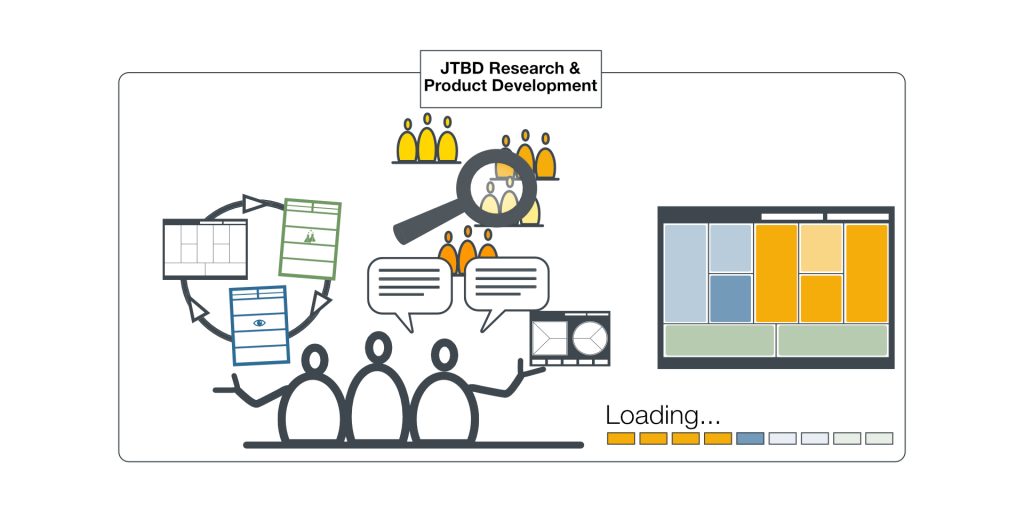8. April 2025
When the job is done – but nothing happens
Jobs-to-be-done interviews are a powerful tool for understanding customer needs and optimising the innovation process. But what if the expected results fail to materialise despite careful execution? In this article, we highlight common stumbling blocks and show how you can achieve real progress through effective hypothesis validation and qualitative market research.

Why good interviews are often ineffective – and how to make the transfer to product, marketing and strategy
JTBD interviews are designed to visualise customer needs – but often nothing happens afterwards. In our podcast episode 94, we talk about the typical stumbling blocks in JTBD research transfer – and how to overcome them. We show you how to use jobs-to-be-done research strategically and systematically transfer results into products, communication and innovation.
By Peter Rochel
Those who conduct qualitative interviews want to understand.
What drives people. Why they buy. Why they switch. Why they hesitate.
But all too often these insights remain inconsequential. They end up in the cupboard, in the drive or in the slide deck – somewhere between gaining knowledge and stopping the project.
Why is that?
This is exactly what I spoke to Jan Milz about.
Lean Product Manager, JTBD researcher since 2013, former Product Owner at XING, now part of the team at Oberwasser Consulting.
What began as a conversation about qualitative research quickly turned into an in-depth analysis of the most common failure: the lack of transfer.
What use are interviews if nobody uses them?
‘We did great interviews – but nobody knew what to do afterwards.’
– Jan Milz
The problem was not in the methodology. Not in the data. But in the system.
In many companies, jobs-to-be-done research is commissioned without a clear mandate.
Without a target definition. Without an idea of how what could be discovered is to be transferred to existing processes.
Explorative? Confirming? The main thing: clarified.
A central misunderstanding:
Good JTBD interviews do not follow traditional guidelines.
They are explorative, retrospective, narrative. They work with depth, not with tables.
‘I didn’t have a guideline – because I wanted to find hypotheses, not confirm them.’
– Jan Milz
Those who order ‘research’ often expect comparability, controllability and measurability.
What they get is causality. Complexity. Context.
And if it doesn’t fit together, the project ends – no matter how good it was in terms of content.
Transfer as a blind spot
The real weak point is not the research. It’s what comes afterwards – or not:
Transfer.
How does a job-to-be-done become a product idea? A marketing message? A business model hypothesis?
Many people can’t answer that. Or they have never planned it.
‘Often a great JTBD interview comes out – and then there’s a team of 30 developers who have long since started coding.’
– Peter Rochel
The price of ambiguity: frustration
Jan describes it as his most common reason for frustration in research:
Results were delivered – but nobody could use them.
‘Not because they were bad. But because they didn’t fit.’
No context. No customer. No purpose.
This is not an exception, but unfortunately the rule. And not just in the start-up sector, but also among established SMEs and corporations.
What helps? A continuous process.
It takes more than interviews. It needs structure.
Together, Jan and I have developed an open, clear JTBD process that doesn’t end with the survey – it starts there.
- A framework that turns interviews into usable data
- A method that clearly explains what the next step is
- A transfer process that translates customer language into strategy – not into a PDF
‘It was the first time that I received a JTBD synthesis result that I could not only read, but also understand and apply.’
– Jan Milz
Jobs-to-be-Done ≠ Jobs-to-be-Done
Another problem is that the term ‘jobs-to-be-done’ is overstretched.
What Tony Ulwick means by this is something completely different from what Bob Moesta means.
One optimises existing solutions. The other is looking for new markets.
Both have their justification. But if the client and service provider do not have the same vision, the result can only be disappointing.
‘Make me a JTBD project’ is about as precise as:
‘Make me an MVP.’
From retreat to reality: JTBD Meetup for practitioners
Frustration at the lack of transfer initially gave rise to an idea:
A retreat – a place where practitioners can learn together, try things out and think more deeply.
Was wir schon jetzt tun, ist ein erster Schritt dahin:
Die JTBD Meetups von Oberwasser Consulting & UTXO Solutions.
People who work with JTBD – or want to start – meet here regularly.
We share experiences, methods, projects and aha moments. Open. Uncomplicated. Without slide battles.
👉 Info & registration for the next Meetup
If this appeals to you – we look forward to hearing from you.
🎧 Listen now
Podcast episode 094 – JTBD Research & Transfer: Why good interviews are often not enough
👉 Listen →
📬 Contact
Want to find out more about our JTBD process?
Or do you know the problem of ‘good research, but no result’ from your own experience?
📩 Simply write to us at info@oberwasser-consulting.de
